Cities today
As the governments closest to the people, cities bring critical value to the health of the state. Cities drive economic health, population growth, and commercial activity in Washington. When the state invests in cities, we all benefit.
In the last decade however, cities have faced evolving challenges, new service demands, structural gaps in revenues and expenditures, and decreasing state commitment to city issues. Despite these trials, cities are doing their part to deliver more and better services to residents—all while leading with innovations to meet new and existing service needs.
Cities squeezed by the Great Recession ten years ago are better off today, but constrained revenues mean they still struggle to meet the growing needs of their communities. Structural issues with city revenues, changes in state and federal shared revenues, and new expenditure challenges have resulted in backlogs in infrastructure upgrades and other needs.
The availability of funding for local services varies widely across the state’s diverse cities depending on their growth, business activity, and other economic conditions. But the state has consistently limited local options for cities to adequately fund their most basic services, meet the needs that accompany population growth, and keep up with the effects of inflation. Further exacerbating the situation, the Legislature has repeatedly swept city assistance programs to help fill state budget gaps.
In short, cities are tasked with doing more than ever before, with less help and financial assistance to do it all.
Cities provide critical value to the state
Basic services like streets, utilities, parks, and public safety impact the daily lives of city residents. They also drive the economic health, population growth, and commercial activity in the state. Cities bring great value to our quality of life. Things like clean water, safe streets, and the accompanying thriving businesses are basic expectations. Without healthy cities, the state cannot thrive.
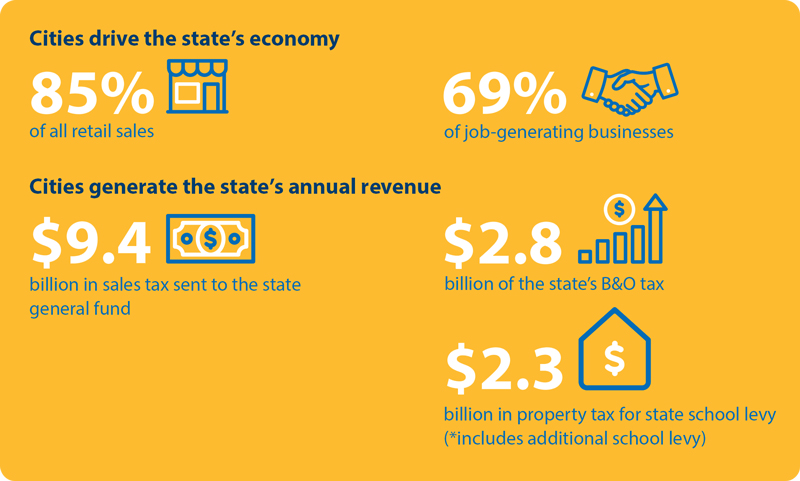
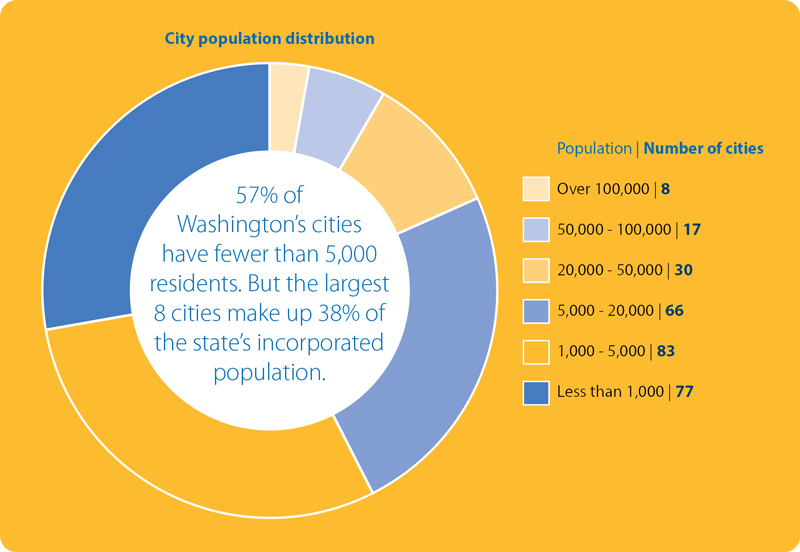
People choose cities to live, work, and play
At their core, cities are communities of people who seek a place that reflects their needs and values. While cities provide core services, they also provide an intangible sense of belonging that draws people to them and creates a connection. The things people love about their city instills their deep connections to their hometowns. This translates into high expectations for their municipal government.
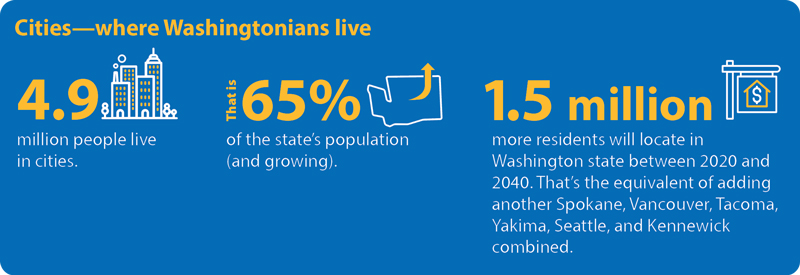
Cities are the governments closest to the people
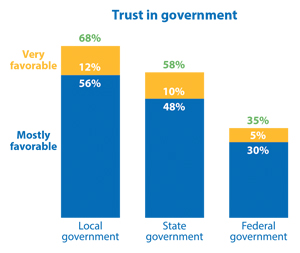 Residents recognize the value of cities and the services they provide. People choose where to live, in part, by considering the things they love about their community. In that respect, it makes sense that city governments so closely reflect the communities that elect them. Local governments consistently score higher in public opinion polls gauging government trust. In 2018, there was a significant gap between how much more favorably people view local government compared to state and federal government.
Residents recognize the value of cities and the services they provide. People choose where to live, in part, by considering the things they love about their community. In that respect, it makes sense that city governments so closely reflect the communities that elect them. Local governments consistently score higher in public opinion polls gauging government trust. In 2018, there was a significant gap between how much more favorably people view local government compared to state and federal government.
Population changes in Washington
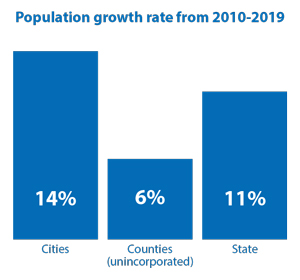 Cities represent 65% of the state’s population and act as growth hubs for the state. It is estimated that the population of Washington will grow by 1.5 million people in the next 20 years, and many will settle in cities.
Cities represent 65% of the state’s population and act as growth hubs for the state. It is estimated that the population of Washington will grow by 1.5 million people in the next 20 years, and many will settle in cities.
Throughout the last decade however, in addition to growth in urban cities and suburbs, areas that were once considered rural have grown substantially. Communities that once had more suburban or rural character and service needs have grown into urban areas and new suburbs. On top of that, the fastest growing cities are dispersed throughout the state due to a combination of migration, job growth, and annexations.
The demographics of cities are also shifting. The state is growing more diverse as communities work to provide flexible services for changing and aging populations.
Cities need the state’s help to meet growing challenges

Cities are consistent about how the state can help with our long-standing needs, including:
- Infrastructure funding
- Local revenue flexibility
- Revising the 1% property tax limit
- Local option revenue tools
- Economic development tools
Throughout the last decade, the major challenges facing cities have evolved to include new service demands that fall outside of the traditional roles of cities. Changes include increasing pressure for affordable housing and human services and the impacts of evolving technology, such as cybersecurity threats.
Local control remains a core theme for cities. Local elected officials are in the best position to know what solutions work best for their communities.
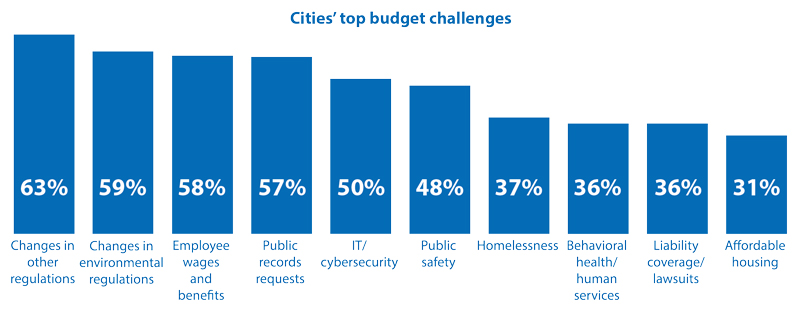
“Strong sales tax growth (8-10% annually) has offset impacts of diminishing property tax revenues, helping our city meet our financial needs. I am concerned about the long-term viability of this trend.”
– Aberdeen, WA, Population: 17,000

“Due to rising costs and less revenue we are struggling to stay above water.”
– Marcus, WA, Population: 175
Overall economic health of cities
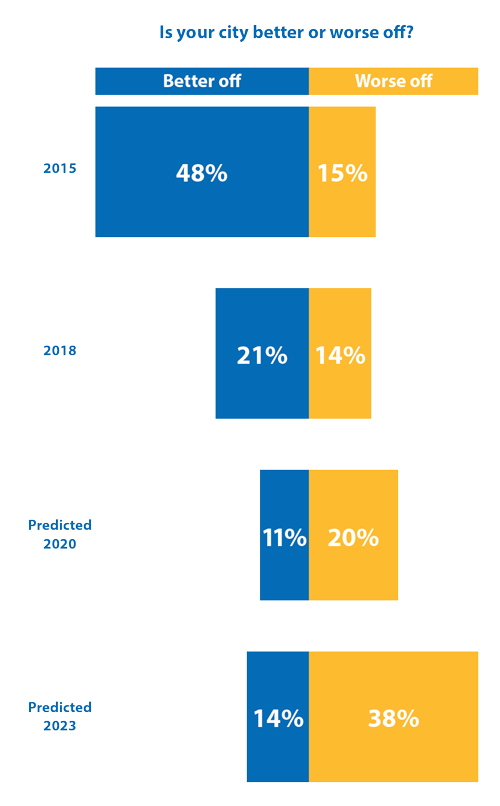 The overall economic health of cities is better for most cities than it was four years ago. That’s partly because population growth, changes to sales taxes, and the growing economy have helped some cities recover from the last recession.
The overall economic health of cities is better for most cities than it was four years ago. That’s partly because population growth, changes to sales taxes, and the growing economy have helped some cities recover from the last recession.
But, looking to the future:
- 20% of cities predict that their situation will be worse in the next year; and
- 38% predict they will be less able to meet basic needs in the next several years.
This is due (in part) to predictions and changing indicators of a possible recession looming in the near term and the fact that many cities heavily rely on growth to overcome structural limits of city revenues.
“Even though we are in one of the most economically healthy regions in the nation, revenues are not keeping pace with the increasing cost of doing business. Kenmore is very dependent on property tax, which can only grow by 1%, thanks to state-imposed limits. While we we’ve already implemented a lot of actions to delay the inevitable, our financial lines are going to cross (operating expenditures will start to exceed operating revenues) in 2021.”
– Kenmore, WA, Population: 23,000
Next chapter: City budgets & finances